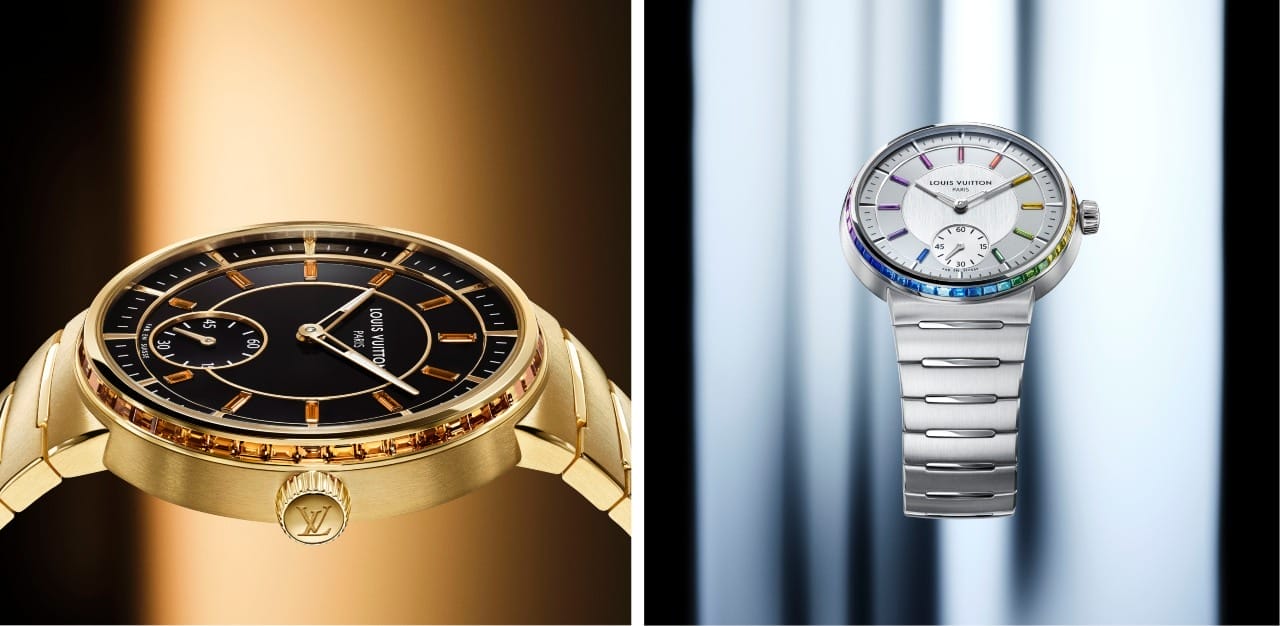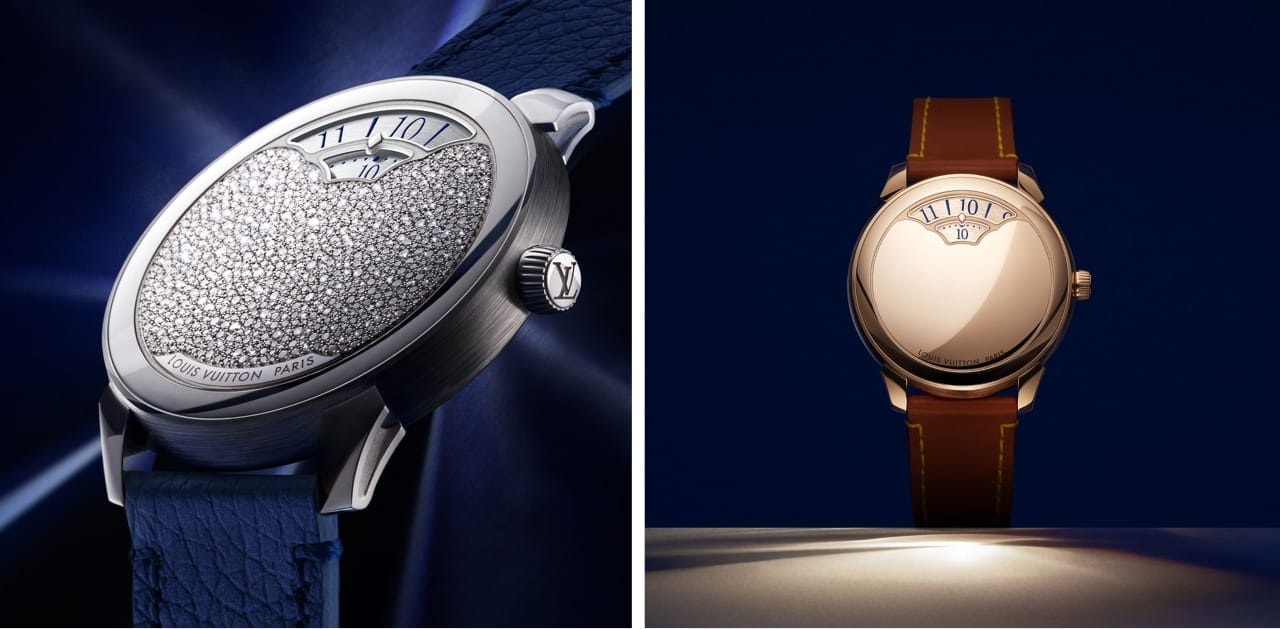It has become something of an annual expectation for Louis Vuitton to make a powerful first quarter statement by unveiling dazzling, highly complicated, and stunningly decorated superstar timepieces. True to form, this year’s releases offer plenty to appreciate in terms of finer details—the sort that experienced watch collectors know to look out for.
 The Tambour Taiko Spin Time is an evolution that incorporates two of Louis Vuitton’s horological signatures: the Tambour case shape, with graceful curves of the case middle, and the Spin Time complication. The latter has been part of the Louis Vuitton line-up since 2019, a unique take on the jumping hour; each numeral is mounted on its own three-dimensional spinning display, inspired by the flap-style timetable boards that were once common in airports and train stations. It was developed by Michel Navas and Enrico Barbasini of La Fabrique du Temps, before the complication was integrated into Louis Vuitton in 2011. “Without Spin Time, we would not have embarked on the challenge of entering high watchmaking in this manner,” said Jean Arnault, watch director of Louis Vuitton, in a statement. “And consequently, we would not have integrated La Fabrique du Temps, which is a founding moment for our watchmaking.”
The Tambour Taiko Spin Time is an evolution that incorporates two of Louis Vuitton’s horological signatures: the Tambour case shape, with graceful curves of the case middle, and the Spin Time complication. The latter has been part of the Louis Vuitton line-up since 2019, a unique take on the jumping hour; each numeral is mounted on its own three-dimensional spinning display, inspired by the flap-style timetable boards that were once common in airports and train stations. It was developed by Michel Navas and Enrico Barbasini of La Fabrique du Temps, before the complication was integrated into Louis Vuitton in 2011. “Without Spin Time, we would not have embarked on the challenge of entering high watchmaking in this manner,” said Jean Arnault, watch director of Louis Vuitton, in a statement. “And consequently, we would not have integrated La Fabrique du Temps, which is a founding moment for our watchmaking.”
 After 16 years, the Tambour Taiko Spin Time is now issued in six limited-edition flavours, all united by a subtle update of design language as seen in the white gold case. The lugs are a standout—a complex form with sections pared away to give it a sense of lightness and openness. The finishing is a combination of the traditional and modern. The hollows of the lugs are frosted with a laser technique, while the polished edges are done by hand, with diamond paste on beechwood wheels. This interplay of dramatically different finishing styles is present throughout the rest of the case, most notably on the bezel, which features a frosted section on which letters spelling out Louis Vuitton stand out in polished relief. The case middle preserves the Tambour’s trademark drum-shaped case—taiko is a type of Japanese ceremonial drum, while the word ‘tambour’ is French for drum. The Taiko case is the most complex produced by Louis Vuitton.
After 16 years, the Tambour Taiko Spin Time is now issued in six limited-edition flavours, all united by a subtle update of design language as seen in the white gold case. The lugs are a standout—a complex form with sections pared away to give it a sense of lightness and openness. The finishing is a combination of the traditional and modern. The hollows of the lugs are frosted with a laser technique, while the polished edges are done by hand, with diamond paste on beechwood wheels. This interplay of dramatically different finishing styles is present throughout the rest of the case, most notably on the bezel, which features a frosted section on which letters spelling out Louis Vuitton stand out in polished relief. The case middle preserves the Tambour’s trademark drum-shaped case—taiko is a type of Japanese ceremonial drum, while the word ‘tambour’ is French for drum. The Taiko case is the most complex produced by Louis Vuitton.
Four new calibres from Louis Vuitton’s La Fabrique du Temps manufacture grace the line-up. All have a 45-hour power reserve and are self-winding via a solid gold rotor—itself a showcase of various finishing techniques. The movement is equipped with colourless, transparent jewels—quite a change from the dark pink of typical jewels—that give it a distinctive, contemporary look. The updated Spin Time mechanism can now be adjusted backwards as well as forwards—a rare quality in jumping hour indicators, let alone one this complex. The Spin Time indicators, traditionally formed as straight-edged cubes, now sport a subtle curvature that softens their visual impact. On the dial side, things are cool and muted, with a dolphin grey hue the dominant theme. The Spin Time cubes are in the same colour, except for the current hour, which is in a lighter grey.
The purest expression of the new collection, the Tambour Taiko Spin Time, is also its smallest, with a 39.5mm case diameter. It features an especially clean layout with only a single minute hand to pair with the hours indication. It also has a jewelled version with 4.3 carats of baguette-cut diamonds on the dial, bezel, lugs, and pin buckle of the rubber strap. This version also gains a hawk’s eye dial in the centre, a type of grey-blue quartz that complements the rest of the watch with its own texture. It is the first time this material has been used in a Louis Vuitton watch.
The rest of the new executions are 42.5mm in diameter, including the Tambour Spin Time Air. Here, the material around the Spin Time indicators is removed, leaving them in their own channel that runs the circumference of the watch. Visually, it is much more dramatic, with each cube seeming to float in mid-air. It emphasises the complication while allowing an unobstructed appreciation of the way it works. This, too, has a jewelled version, consisting of more than 1,000 diamonds in a snow setting on the lugs, cubes, dial centre, and hawk’s eye chapter ring.

The Tambour Taiko Spin Time Air Tourbillon kicks this up a notch by including a centrally mounted flying tourbillon. This alone is an unusual and impressive horological achievement. Integrating it alongside the Spin Time complication, which takes up much of the watch’s available space, is an entirely different feat altogether. The end result is one of poetic complements—while the Spin Time indications occupy the perimeter of the watch and are in action once per hour, the centre of the watch showcases an always-in-motion tourbillon that is shaped after the brand’s iconic Monogram flower. Notable also is the minute hand, which was re-engineered to operate under and around the tourbillon.
Last and possibly most curiously is the Tambour Taiko Spin Time Air Antipode, which leverages the Spin Time mechanism to create a unique travel time complication—a patented world first, in fact. Hours are indicated more conventionally, with a yellow arrow pointer mounted in a rotating disc with a world map graphic. World time is read thanks to the Spin Time indicators that are marked with cities around the world—two per cube, one day and one night, representing time zones 12 hours apart.
Although the Tambour Spin Time Taiko is the most significant of this year’s launches, it is not the only highlight. The new Tambour Convergence is another as it is a rather elegant and vintage-inspired timepiece—minimalist, save for a pair of window indications for the hour and minutes. At only 37mm in diameter and 8mm thick, in its pink gold guise it is dressy and discreet, even as it is unusual. Those looking for a bit more flash will find it in the platinum and diamond-set variant. This has 795 snow-set diamonds on its front plate, requiring particular attention to be paid to each gem’s differing size so as to create a continuous, cohesive piece. This alone required 32 hours of work to complete.

There are also a pair of Tambour High End releases—precious takes on the re-styled Tambour of 2023, which featured a slimmed-down profile and the addition of an integrated bracelet. These new executions remain simple in concept, being time-only, small seconds models, but have an elegant touch that sets them apart. The first has its 40mm case built in yellow gold, a contrast to the deep black of its onyx dial—itself contrasted again with baguette-cut saffron-coloured sapphires for indices. Similar gems are also found on the bezel.
A second version with a platinum case has a similar concept, only with a rainbow of different-coloured gems instead—a sequence of sapphires and rubies arranged by colour to form a gradient.






